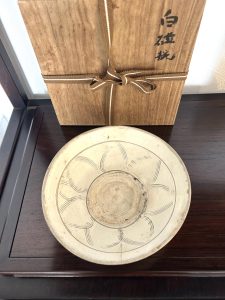ナスカの地上絵、想像以上に親近感がわきます(愛知県名古屋市千種区姫池通 骨董買取 古美術風光舎)
2024.09.27
皆さまこんにちは、スタッフHでございます。
昨日のスタッフYの小鹿田焼のブログ、とても感慨深いものがありました。
遥か昔、日々の料理に苦戦していた頃にお祝いに頂いたのが小鹿田焼の「飛びかんな」の中皿でした。つたない料理が別物に変身したかのように美味しそうに見え、お皿の力を実感した瞬間でした。
本日店内に仲間入りしております白磁碗。花びらのような紋様がのびのびと描かれ、こちらの器もきっとあらゆるものを受け止めてくれるはずという大らかさを感じます。


しばらく器を眺めておりますと、また突飛な想像ですが先日ニュースで見たナスカの地上絵を思い浮かべてしまいました。
山形大学ナスカ研究所とIBM研究所の共同研究プロジェクトが、6カ月間のAIを用いた現地調査により新たに303個の地上絵を発見したと報告しました。これにより確認済みの地上絵が倍になったそうです。
ナスカの地上絵の存在はもちろん知っていましたが、有名なハチドリやサルの絵ぐらいしか思い浮かばず、そんなに多くの種類があるのかと驚きました。
ナスカ文化が栄えたのは紀元前100年~800年の900年間とされ、宗教的中心地はナスカ川流域の「カワチ遺跡」です。ナスカの土器は色鮮やかで美しく、動物や草花、戦士や神様をモチーフにしたものが多く見られます。文字を持たなかった文明だったため絵は重要なコミュニケーションの道具だったと考えられています。
それにしてもあまりに自由でユニークなデザインの数々。改めて調べて見てみると、「カールおじさん?」「ケロロ軍曹?」「インベーダーゲームのキャラクター?」と思われる絵もあり親近感が半端ないのです。
地上からは絵を確認することが難しく、飛行機が発明された後1939年に初めて上空より発見され、1994年に世界文化遺産に登録されました。
描いた方法は、歩数で距離を測り、小石をどけながら描いていたことが分かっています。そのため人の歩幅の違いにより左右対称になっていないものもあるとか。もし人が線上を歩いていたなら一筆書きで描かれているのも納得がいく気がします。
地上絵が描かれたナスカ台地は一面に太陽に照らされて黒褐色に変色した小石が広がり、これらの小石の下に白い砂の地層があります。この黒と白のコントラストにより線タイプと面タイプの2種類の地上絵が描かれました。
線タイプの絵は平地にのみ描かれ64%が野生動物をモチーフとし、小型の面タイプの絵は山の斜面などにも描かれ人間や家畜などが81%を占め、目的によって描き分けられていたと考えられています。
線タイプの地上絵はなんらかの儀式活動を行っていたようで、地上絵の上を歩いていた痕跡も残っているそうです。わざと落として割った土器の欠片なども多数発見され儀式の際に土器を割るという習慣があったようです。
一方、面タイプは小道の合流地点の丘などに描かれ、通る人々の目印になっていたと推測されています。
他にも天体観測に使われていたという説などもあり未だ謎に包まれている部分は多く、興味が尽きることはないようです。
それにしても不思議なのは1000年以上も前の地上に描かれた絵が消えずに残っていることです。
どう考えても不可能な気がしますが、第一の理由としてナスカの地では1500年以上ほとんど雨が降っていないことが挙げられます。年間降水量が平均4mmとありえないほどの乾燥地帯なのです。
次にナスカでは絶妙な強さで風が吹いているとのこと。積もりそうな砂を吹き飛ばしてくれるため、砂漠であっても砂に埋もれてしまうことがありません。
また動物が生息していないため踏み荒らされる心配がないそうです。
他にも大地に硫酸カルシウムが多く含まれているため土が固く、霧もおおいため硫酸カルシウムと水分が混ざり合い、さらに強固な大地となり地上絵を守ってきました。
その後、地上絵が発見された後は多くの人々の保全活動により現在まで守られてきました。
偶然が重なった自然環境と人々の努力により、今も遥か昔の人々の暮らしに思いを馳せることができるのですね。
しかし考えてみると、雨も降らず、動物も住みつかないような厳しい環境でよく人々が生活を続けられたものだと思ってしまうのですが、個性豊かな絵を見ていると、豊かな心を持った人々だったのかなと勝手に想像してしまいます。
それでは、また次の機会に。
Hello everyone, this is Staff H.
I was very deeply moved by Staff Y’s blog yesterday about Kogada-yaki pottery.
A long time ago, when I was struggling with cooking, I received a “flying kanna” medium plate from Kogada-yaki as a gift. It was a moment when I realized the power of plates.
The white porcelain bowls that have joined our store today, with their petal-like patterns drawn spontaneously, give a sense of generosity that will surely accept all kinds of things.
Looking at the bowls for a while, I was reminded of the Nazca Lines that I saw on the news the other day, although this is a bit of an outlandish imagination.
A joint research project between the Nazca Research Institute of Yamagata University and the IBM Research Institute reported the discovery of 303 new terrestrial paintings through a six-month field survey using AI. This has doubled the number of confirmed terrestrial paintings.
I knew of the existence of the Nazca Lands, of course, but I could only think of the famous hummingbirds and monkeys, and was surprised that there were so many different types of paintings.
The Nazca culture flourished for 900 years, from 100 to 800 B.C., and its religious center is the Kawachi site in the Nazca River basin. Nazca pottery is colorful and beautiful, often featuring motifs of animals, plants, flowers, warriors, and gods. As a civilization that did not have a written language, painting is thought to have been an important communication tool.
Nevertheless, the designs are so free and unique. When I looked them up again, I found myself asking myself, “Uncle Karl? Sergeant Keroro? Invader game characters? Some of the pictures are so familiar that it is difficult to see them from the ground.
It was difficult to see the paintings from the ground, and they were first discovered from the sky in 1939, after the invention of the airplane, and registered as a World Cultural Heritage in 1994.
It is known that the painters measured the distance by the number of steps they took and painted while moving pebbles out of the way. Therefore, some of the paintings are not symmetrical due to differences in people’s strides.
The Nazca Plateau, where the paintings were drawn, is covered with pebbles that have turned blackish brown in the sun, and there is a layer of white sand beneath these pebbles. The contrast between the black and white areas created two types of terrestrial paintings: line-type and surface-type.
Line-type paintings were painted only on the plains and 64% of them depicted wildlife motifs, while smaller surface-type paintings were painted on mountain slopes and 81% of them depicted humans and domestic animals.
Line-type paintings seem to have been used for some kind of ceremonial activity, and there are traces of people walking on them. Many of the pottery pieces were intentionally dropped and broken, suggesting that there was a custom of breaking them for ceremonial purposes.
On the other hand, it is assumed that the mask type was used as a marker for people passing by, as it was carved into a hill at the confluence of paths.
There are also other theories, such as the theory that they were used for astronomical observation, and there are still many parts that are shrouded in mystery, so there seems to be no end to the interest.
What is still a mystery is the fact that pictures drawn on the ground more than 1,000 years ago have remained on the ground.
It seems impossible, but the first reason is that there has been almost no rainfall in Nazca for more than 1,500 years. It is an impossibly arid region with an average annual rainfall of 4 mm.
Secondly, the wind blows with exquisite strength in Nazca. It blows away the sand that might accumulate, so even if it is a desert, you will not be buried under sand.
They also do not have to worry about being trampled because the area is not inhabited by animals.
In addition, the soil is hard because it contains a lot of calcium sulfate, and because of the abundance of fog, calcium sulfate and moisture mix to form a stronger soil that protects the paintings on the ground.
After the discovery of the terrestrial paintings, they have been protected by the conservation activities of many people.
Thanks to the natural environment and the efforts of people who have protected it, we can still recall the lives of people long ago.
However, when I think about it, I wonder how people could continue to live in such a harsh environment where there is no rain and no animals can live, but when I see the rich individuality of the paintings, I imagine that the people had rich hearts.
I will see you next time.
*******************
ご実家の整理やお片付けなどをされている方のご相談などが多くございます。
お片付けなどくれぐれもご無理のないようになさってくださいませ。
風光舎では古美術品や骨董品の他にも絵画や宝石、趣味のお品など様々なジャンルのものを買受しております。
お片付けをされていて、こういうものでもいいのかしらと迷われているものでも、どうぞお気軽にご相談下さいませ。
また風光舎は、出張買取も強化しております。ご近所はもちろん、愛知県内、岐阜県、三重県その他の県へも出張いたします。
まずは、お電話お待ちしております。
愛知県名古屋市千種区姫池通
骨董 買取【古美術 風光舎 名古屋店】
TEL052(734)8444
10:00-18:00 OPEN

